Marketmore cucumbers have gained immense popularity for their superior quality and delicious taste. Whether you’re looking to buy organic marketmore cucumbers online or grow your own fresh supply, this article will provide you with all the tips and tricks you need to know. Get ready to discover the best ways to cultivate marketmore cucumbers, from ideal growing conditions to effective pest control methods.
Key Takeaways:
- Marketmore cucumbers are highly sought after for their exceptional quality and flavor.
- They require warm weather, well-draining soil, full sun, and regular watering for optimal growth.
- Marketmore cucumbers can be directly seeded in the ground or started indoors and then transplanted outside.
- They are resistant to common diseases and pests, making them easier to grow and maintain.
- Harvest marketmore cucumbers when they reach 7-8 inches in length for the best taste and texture.
Best Conditions for Growing Marketmore Cucumbers
To successfully grow Marketmore cucumbers, it is essential to provide them with the best growing conditions. Here are some key factors to consider:
Soil Requirements
Marketmore cucumbers thrive in well-drained, sandy soil. It is important to ensure that the soil has good drainage to prevent waterlogging, as excessive moisture can lead to root rot. The ideal pH range for Marketmore cucumbers is between 5.8-7. Adding organic matter, such as compost or aged manure, to the soil can improve its fertility and water-holding capacity.
Sunlight Requirements
Full sun is crucial for the healthy growth of Marketmore cucumbers. They require a minimum of 6-8 hours of direct sunlight each day. Inadequate sunlight can result in weak and spindly plants, as well as reduced fruit production. Therefore, it is important to choose a sunny location for planting your cucumbers.
Watering
Marketmore cucumbers have high water requirements and need consistent moisture throughout their growth period. It is important to water them regularly and keep the soil evenly moist. However, take care not to overwater, as this can lead to root diseases. When watering, it is advisable to avoid wetting the foliage to prevent the spread of fungal diseases.
Fertilizing
To ensure healthy growth and optimal yield, it is recommended to fertilize Marketmore cucumbers every 30 days. You can use a balanced fertilizer with a ratio of 2-3-6 or apply aged compost. This will provide the plants with essential nutrients, such as nitrogen, phosphorus, and potassium, which are necessary for their overall development.
Mulching
Mulching is beneficial for Marketmore cucumbers as it helps to retain soil moisture, regulate temperature, and suppress weed growth. Organic mulches, such as straw or shredded leaves, can be applied around the plants to a depth of 2-3 inches. Mulching also protects the cucumber fruits from direct contact with the soil, reducing the risk of rotting or contamination.
By ensuring the best conditions for growing Marketmore cucumbers, you can enjoy a bountiful harvest of these delicious and nutritious cucumbers.
| Growing Conditions | Requirements |
|---|---|
| Soil | Well-drained, sandy soil with a pH of 5.8-7 |
| Sunlight | Full sun for at least 6-8 hours per day |
| Watering | Regular watering to keep the soil evenly moist |
| Fertilizing | Apply a balanced fertilizer every 30 days or use aged compost |
| Mulching | Apply organic mulch to retain moisture and regulate temperature |
Planting and Transplanting Marketmore Cucumbers
When it comes to planting and transplanting Marketmore cucumbers, there are a few options to consider. You can choose to directly seed them outdoors, grow them in containers, or start the cucumber seeds indoors. Each method has its advantages, and it’s important to choose the one that suits your gardening preferences and climate.
Direct Seeding Marketmore Cucumbers
To directly seed Marketmore cucumbers outdoors, wait until 6-8 weeks after the last frost date before planting. Ensure the soil is warm and the temperature ranges between 70°F-90°F. Select a sunny location in your garden and prepare the soil by loosening it with a garden fork or tiller. Sow the cucumber seeds ½-1 inch deep and space them 18 inches apart. If you are planting multiple rows, leave 36-48 inches of space between the rows. However, if you plan to use a trellis or tomato cage, you can reduce the space between rows to 24-36 inches. Germination typically takes 5-10 days.
Starting Marketmore Cucumber Seeds Indoors
If you want to get a head start on the growing season, you can start Marketmore cucumber seeds indoors. Begin sowing the seeds in trays or pods 2-3 weeks after the last frost date. Fill the containers with a good-quality seed starting mix, and plant the seeds ½-1 inch deep. Keep the soil consistently moist and provide a warm environment for germination. Once the seedlings have developed a few true leaves and the weather is suitable, transplant them outside, ensuring the temperature is between 70°F-90°F.
Transplanting Marketmore Cucumbers
If you prefer to start your cucumbers indoors but don’t want to plant them directly in the ground, you can transplant the seedlings into your garden or containers. Wait until the weather has warmed up and the plants have grown to a suitable size. Choose a location that receives full sun and has well-draining soil. Dig holes that are slightly larger than the root ball of each seedling and space them 18 inches apart. Plant the seedlings at the same depth as they were in their containers, firm the soil gently around the roots, and water thoroughly.
Remember to water your Marketmore cucumbers regularly, especially during hot and dry periods. They prefer consistently moist soil but avoid overwatering, as it can lead to root rot. Providing a trellis or tomato cage for support can help the vines grow vertically and save space in your garden. The use of organic mulch can also help retain moisture and reduce weed growth.
Planting Marketmore cucumbers can be done through direct seeding outdoors, starting seeds indoors, or transplanting seedlings. Choose the method that suits your needs and enjoy the process of growing these delicious cucumbers.
| Method | Advantages | Disadvantages |
|---|---|---|
| Direct Seeding Outdoors | Simple and straightforward | Susceptible to pests and diseases |
| Starting Seeds Indoors | Allows for early planting and extended growing season | Requires additional indoor space and care |
| Transplanting Seedlings | Ensures a higher success rate and controlled environment | Requires time and effort to transplant |
Growing and Maintaining Marketmore Cucumbers
When it comes to growing Marketmore cucumbers, providing the right conditions is essential. These cucumbers thrive in warm and sunny environments, making them perfect for summer gardens. However, proper maintenance is also crucial to ensure a successful harvest and healthy plants.
Caring for Marketmore Cucumbers
To start, it’s important to ensure that the soil is well-drained and rich in organic matter. This will provide the necessary nutrients for the cucumber plants to grow and thrive. Regular watering is also crucial to keep the soil evenly moist. Be careful not to overwater, as excessive moisture can lead to root rot and other problems.
One useful technique for maintaining moisture and controlling temperature is to apply mulch on top of the soil. Mulch helps in retaining moisture and reducing water evaporation, keeping the soil consistently moist. It also acts as insulation, regulating temperature fluctuations and protecting the cucumber plants.
Disease-Resistant Marketmore Cucumbers
One advantage of growing Marketmore cucumbers is their natural resistance to common cucumber diseases. They are less likely to suffer from scab, mosaic virus, and mildew. However, it’s still important to monitor the plants for any signs of disease and take appropriate action if necessary.
Additionally, promoting healthy growth is crucial in preventing diseases. One method is to side dress the plants with nitrogen fertilizer after the vines develop runners. This will provide the necessary nutrients to support vigorous growth and increase disease resistance.
By following these guidelines for growing and maintaining Marketmore cucumbers, you can increase the chances of a successful harvest of these delicious cucumbers. Providing the right growing conditions and caring for the plants will ensure healthy, disease-resistant cucumbers that can be enjoyed fresh or used in various recipes.
Pests and Diseases of Marketmore Cucumbers
When growing Marketmore cucumbers, it’s important to be aware of the common pests and diseases that can affect these plants. While Marketmore cucumbers are generally resistant to many pests and diseases, it’s still essential to take preventive measures to ensure their health and productivity.
Common Pests of Marketmore Cucumbers
Marketmore cucumbers are known for their natural resistance to pests, including aphids and cucumber beetles. However, in case of any infestation, you can easily control these pests using organic methods. Handpicking the pests or using insecticidal soap or neem oil can effectively eliminate them from your plants.
To further deter pests, consider planting companion plants like corn, dill, marigolds, nasturtiums, beets, radishes, and carrots. These plants act as natural repellents, reducing the likelihood of pest damage.
Diseases of Marketmore Cucumbers
Marketmore cucumbers have a reputation for being resistant to several diseases, such as scab, mosaic virus, and mildew. However, maintaining optimal growing conditions and practicing proper care can significantly reduce the risk of diseases.
To prevent diseases, ensure that your cucumber plants have well-draining soil and receive adequate sunlight. Avoid overwatering, as excessive moisture can create favorable conditions for diseases to develop. By providing the right growing conditions and avoiding stress on the plants, you can help them stay healthy and disease-free throughout the growing season.
| Pests | Diseases |
|---|---|
| Aphids | Scab |
| Cucumber beetles | Mosaic virus |
| Mildew |
Harvesting Marketmore Cucumbers
Harvesting Marketmore cucumbers at the right time is essential to enjoy their fresh and delicious flavor. When they reach a length of 7-8 inches, they are ready to be picked from the vine. Harvesting them daily not only ensures a continuous supply of cucumbers but also stimulates further production.
To maintain optimal taste and texture, it is crucial to pick Marketmore cucumbers when they are still young and tender. Overripe cucumbers tend to be bitter and may not be as enjoyable. To harvest, it is recommended to use a sharp knife or pruners to cut the cucumber directly from the vine. This method helps prevent damage to the plant and ensures that the remaining cucumbers continue to grow and thrive.
Once harvested, Marketmore cucumbers can be used in a variety of dishes, from refreshing salads to pickles and sandwiches. Their versatility makes them a staple in many kitchens, offering a crisp and refreshing addition to any meal.
Growing Marketmore Cucumbers in Containers
If you don’t have a large garden or prefer the convenience of container gardening, you’ll be pleased to know that Marketmore cucumbers can be successfully grown in containers. Container gardening allows you to cultivate these delicious cucumbers even if you have limited space available.
To start growing Marketmore cucumbers in containers, there are a few important considerations to keep in mind. First, choose a container that is at least 12 inches deep and wide. This will provide enough room for the cucumber plant’s roots to spread out and grow. It’s also essential to ensure that the container has proper drainage holes to prevent waterlogging and root rot.
Once you have the right container, fill it with a mixture of peat moss, compost, and potting soil. This combination will provide the necessary nutrients and moisture retention for the cucumber plant. Keep in mind that Marketmore cucumbers prefer well-draining soil, so make sure that the soil mixture allows excess water to drain away.
Place the container in a location that receives at least six hours of sunlight per day. Marketmore cucumbers thrive in full sun, which is essential for their growth and fruit production. However, in hot climates, it may be necessary to provide partial shade during the hottest part of the day to prevent the cucumber plant from overheating.
Regular watering is crucial for container-grown cucumbers. Check the soil moisture regularly and water the plant whenever the top inch of soil feels dry. Avoid overwatering, as this can lead to root rot and other problems. It’s best to water the plant at the base, rather than overhead, to minimize the risk of foliage diseases.
To give your container-grown Marketmore cucumbers the best chance for success, consider providing a trellis or some form of support for the vines to climb. This will help save space and encourage vertical growth, allowing the cucumbers to grow without crowding the container.
In conclusion, growing Marketmore cucumbers in containers is a practical and rewarding way to enjoy fresh cucumbers, even with limited space. The right container, well-draining soil, ample sunlight, regular watering, and appropriate support for the vines are all key factors for successful container gardening with Marketmore cucumbers.
Best Companion Plants for Marketmore Cucumbers
Marketmore cucumbers thrive when planted alongside certain companion plants. These companions not only enhance the growth and health of the cucumbers but also provide additional benefits. Some excellent companion plants for Marketmore cucumbers include:
- Corn: Corn serves as a natural trellis for the cucumber vines, allowing them to climb and providing shade.
- Dill: Dill attracts beneficial insects that prey on cucumber pests, such as aphids and cucumber beetles.
- Marigolds: Marigolds repel harmful insects and nematodes while adding vibrant colors to the garden.
- Nasturtiums: Nasturtiums attract aphids away from the cucumbers, acting as a sacrificial plant.
- Beets: Beets help loosen the soil, preventing it from becoming compacted around the cucumber roots.
- Radishes: Radishes act as a natural repellent against cucumber beetles and other pests.
- Carrots: Carrots help to improve soil structure and provide a complementary root system with the cucumbers.
These companion plants work together with Marketmore cucumbers, creating a harmonious and beneficial environment in the garden. The combination of shade, pest control, and soil improvement promotes healthy growth and maximizes yield.
It is important to avoid planting Marketmore cucumbers with melons, potatoes, and sage, as they may compete for resources and hinder each other’s growth.
So, when planning your garden, consider the benefits of these companion plants and enjoy a thriving cucumber patch.
Benefits of Marketmore Cucumbers
Marketmore cucumbers offer several benefits that make them a great addition to a healthy diet. Here are some of the key advantages:
- Low in fat, protein, and carbohydrates: Marketmore cucumbers are a low-calorie vegetable, making them a guilt-free choice for those watching their weight. They are naturally low in fat, protein, and carbohydrates, making them a healthy option for meals and snacks.
- High water content: Cucumbers are made up of about 96% water, which makes them an excellent hydrating food. Incorporating Marketmore cucumbers into your meals can help you stay hydrated throughout the day.
- Rich in beta carotene: Marketmore cucumbers are a good source of beta carotene, a powerful antioxidant that helps promote healthy skin and supports eye health. Including these cucumbers in your diet can contribute to overall well-being.
Marketmore cucumbers can be enjoyed fresh as part of salads, sandwiches, or as a refreshing snack. They can also be used in a variety of recipes, adding a crisp and refreshing taste to dishes.
So, whether you’re looking to add more nutrients to your meals or simply enjoy a delicious and hydrating vegetable, Marketmore cucumbers are a fantastic choice.
Stay refreshed and nourished with the many nutritional benefits of Marketmore cucumbers!
Conclusion
Growing Marketmore cucumbers can be a fulfilling and rewarding journey for any gardener. By implementing the appropriate planting and care techniques, you can yield a plentiful harvest of these delectable cucumbers. Remember to create the ideal growing conditions, take preventive measures against pests and diseases, and harvest the cucumbers at the optimal time.
Whether you choose to cultivate them in your garden or in containers, Marketmore cucumbers are a versatile and nutritious vegetable that can enhance your culinary endeavors. Their exceptional taste and crisp texture make them a delightful addition to salads, sandwiches, and refreshing summer beverages.
In summary, with dedication and attention to detail, you can enjoy the abundant benefits of cultivating Marketmore cucumbers. From their exceptional flavor to their numerous health advantages, these cucumbers are a valuable addition to any garden. So, roll up your sleeves, get your hands dirty, and embark on the journey of growing your own Marketmore cucumbers!

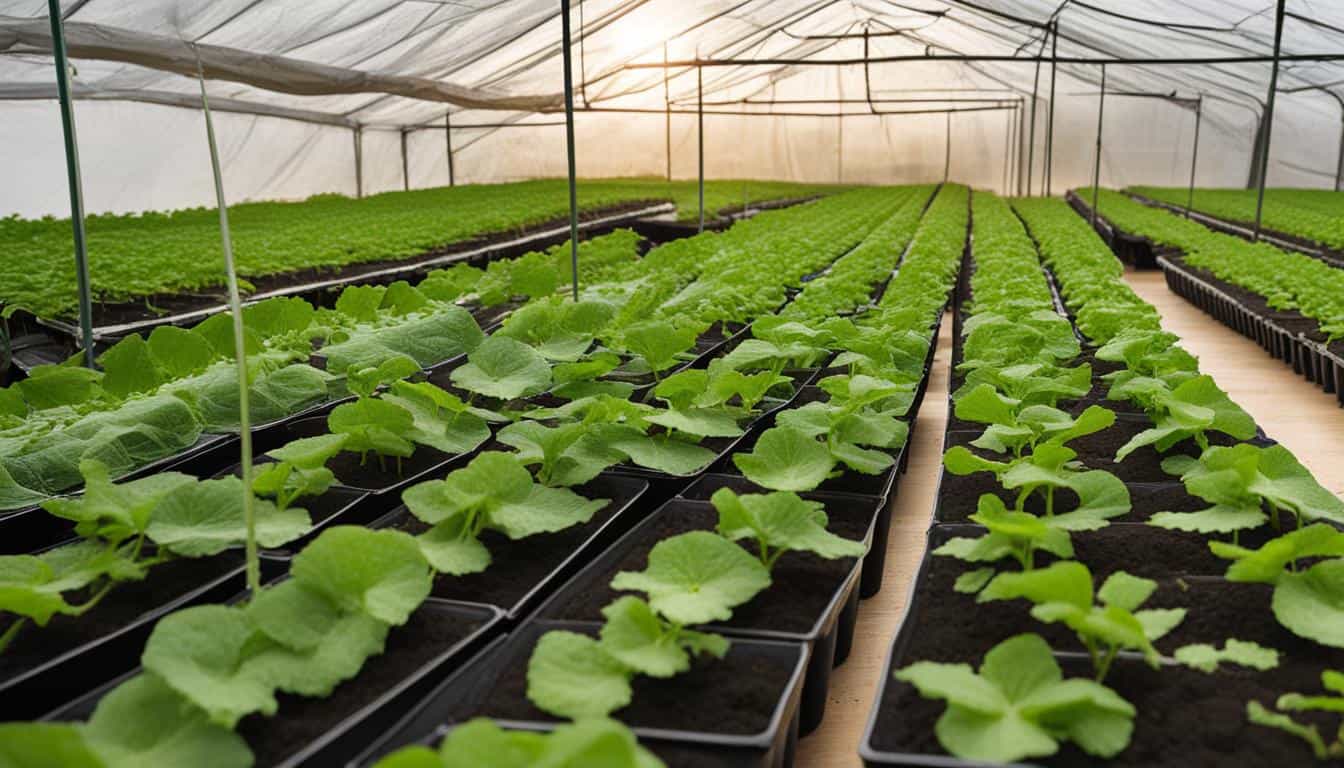
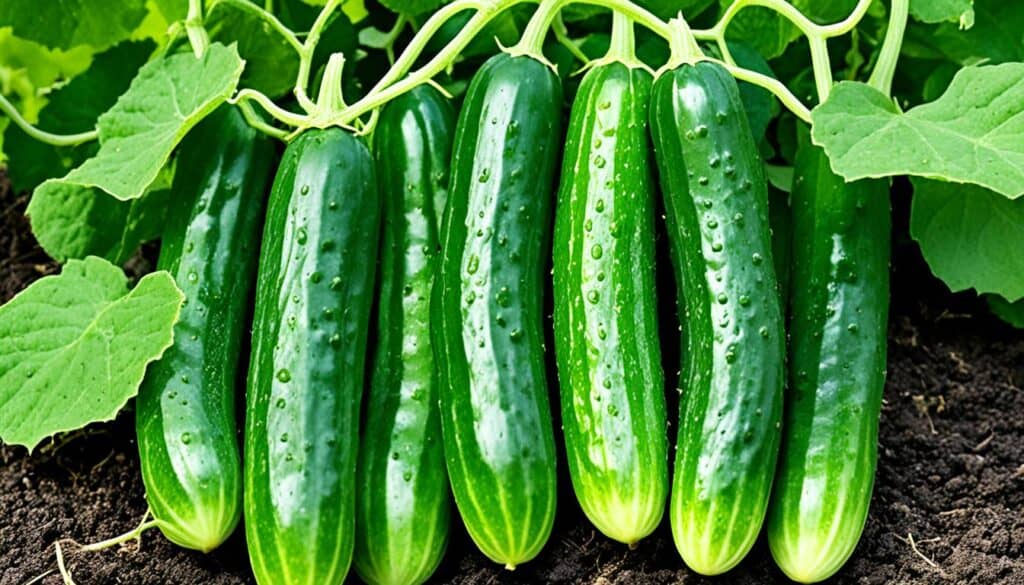
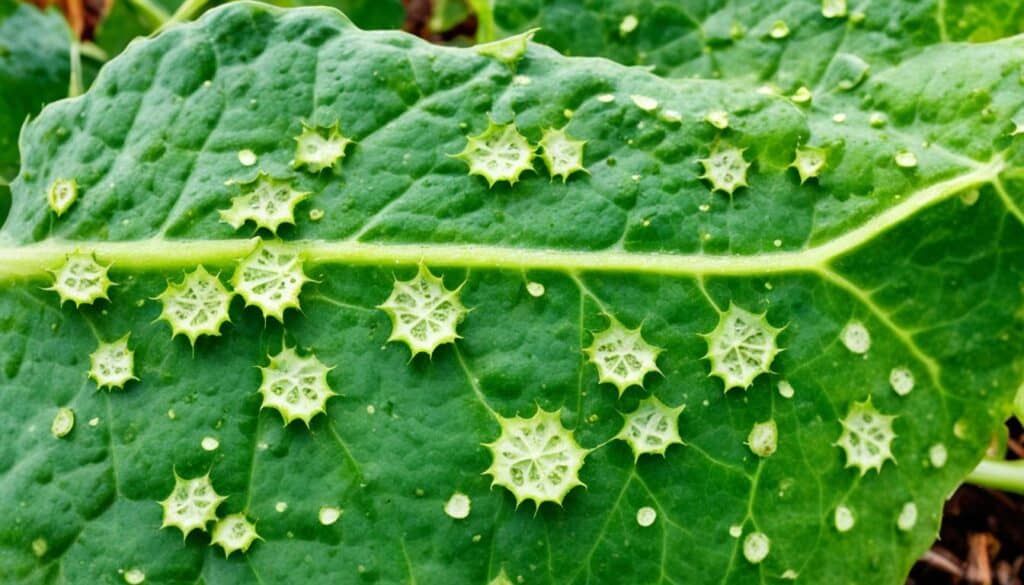
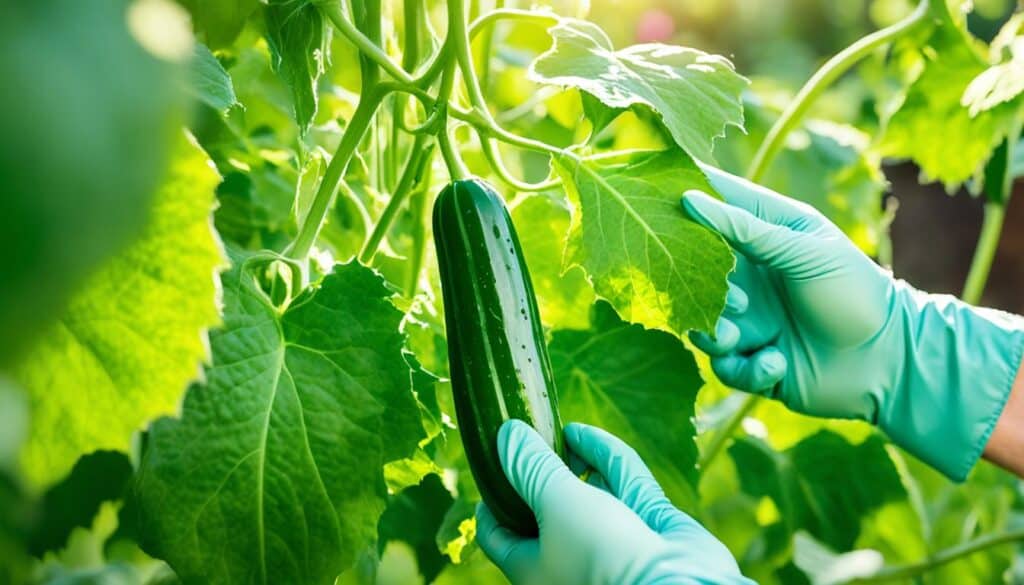
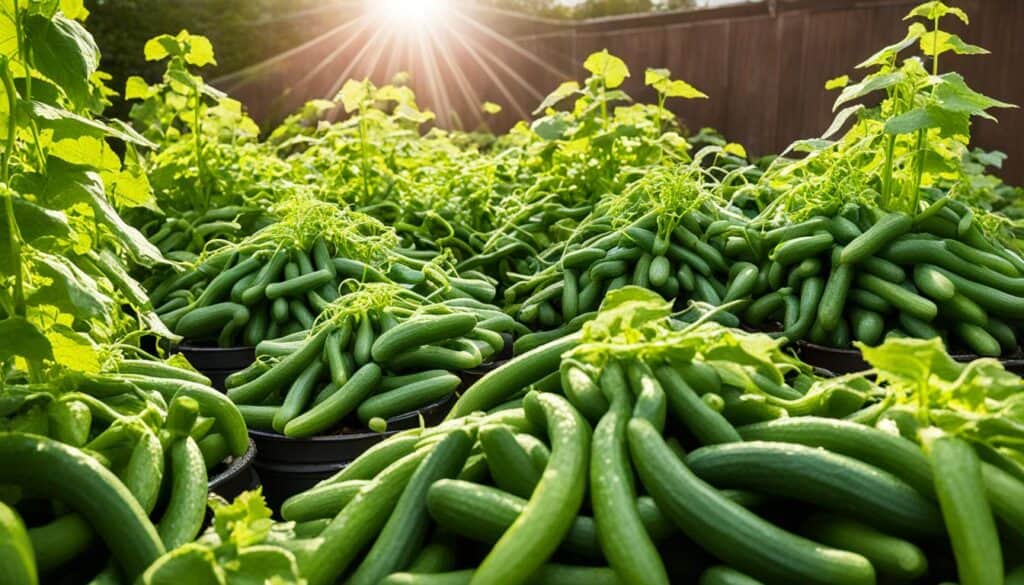




Leave a Reply